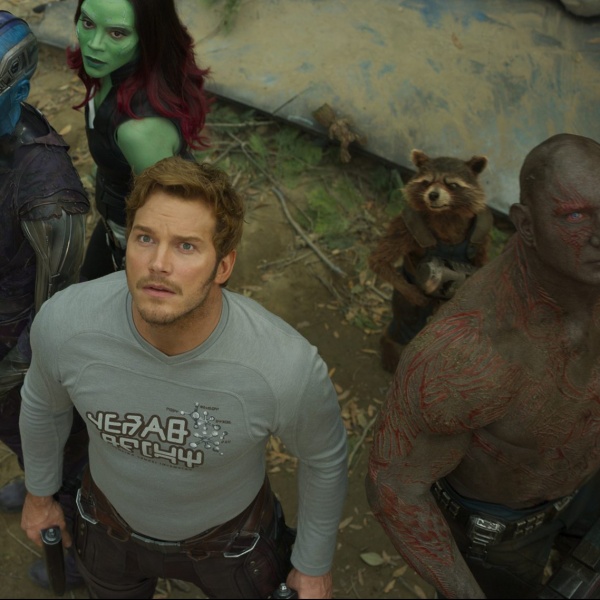
For months now, through a barrage of teasing promotional materials, one question has remained about Zack Snyder‘s glitzy passion project “Sucker Punch” – what, exactly, is it? Is it a period drama about a young girl in a mental institution? Is it a dream world thriller a la “Inception“? Or is it some kind of experimental action film, in which characters take on dragons in one sequence and silvery robots in the next? Well, it turns out that the final product is all of these, and none of these things. It sure is noisy, though (especially if you watched it in IMAX like we did).
A Warner Bros. logo partially obscured on a red velvet curtain precedes the film. It’s a striking image, but it’s one wholly borrowed from Baz Luhrmann‘s wondrous “Moulin Rouge!” and, mere seconds later, we hear how heavily indebted (oddly enough) the film is to Luhrmann’s masterpiece. Strings swell, but they’re playing something familiar — it’s a re-jiggered version of “Sweet Dreams (Are Made of These)” by the Eurythmics sung by Emily Browning. As we push in, the curtain parts and the “stage of the movie” is revealed. This is all pretty cool, besides its obvious derivativeness, but it’s a good metaphor for the movie itself – all cool bullshit, no real meaning.

The film opens in earnest in a prolonged, wordless sequence with Baby Doll (Browning) losing her mother and then fearing for her life from an abusive stepfather who wants the inheritance left behind exclusively in the hands of his stepdaughters. Of course, he is so cartoonishly drawn that our friend leaned over and said after watching the stepfather swill booze and menacingly adjust his necktie, “He’s a bad guy, right?” In the struggle against the stepfather, who may or may not be trying to rape her younger sister (you can feel the MPAA cuts here) Baby Doll tries to shoot him but misses, killing her sibling instead. The stepfather brings her to the Lennox mental institution, which seems to be populated exclusively with pretty young girls. And if you had any doubt that this was a Zack Snyder movie, everything you just read is done in slo-mo. Anyway, he tips the slimy warden Blue Jones (Oscar Isaac) $2,000 to have his stepdaughter lobotomized at the end of the week – so the clock is ticking!
Except that it isn’t. Because the film’s loose structure, which is really a coat hanger on which Snyder drapes all sorts of dizzy visual fantasias, openly allows for flights of fancy. And pretty soon, we’re thrust into Baby Doll’s dream world, which is again set in the 1950s but instead is a kind of bordello/crime den. Her doctor (Carla Gugino wearing an outrageous “Polish” accent) is recast as the head of the brothel, and her sisters-in-arms are strippers, hence the names Amber (Jamie Chung), Sweet Pea (Abbie Cornish), Blondie (Vanessa Hudgens) and Rocket (Jena Malone). From there we zoom into a secondary alternate realm where the girls take on the identity of an elite fighting squad. If this sounds confusing, it is, but worse than that, it dilutes any kind of emotional connection or understanding of the characters or what they’re going through since so much of the time they’re engaged in meaningless theatrics on other planes of existence.
It’s these extended fantasy sequences which make up most of the movie. The girls are tasked with compiling several items (among them: a key, a map, a knife and “fire” – what are they, Neanderthals?), and each time they slip into the alternate universe, they enter a place seemingly grabbed from the Big Bag of Science Fiction and Fantasy Clichés, or at the very least Questionable Videogame Levels. There’s a WWI-themed trench warfare sequence, with the girls facing off against mechanized German soldiers; a runaway bullet train teaming with villainous robots and cresting towards a prog-rock-album-cover futuristic city; a medieval castle overrun with (no joke) orcs and dragons and a snowy samurai set that looks not unlike a “Mortal Kombat” setting we’re pretty sure we’ve played or a rejected set design for “Kill Bill.” If you aren’t rolling your eyes by now, then you aren’t paying attention.
There’s a lot wrong with these sequences — Snyder’s handling of the geography of these battles seems to be completely lost here — but most egregious is how utterly boring these worlds are. The character designs, the settings, the color schemes — on nearly every fundamental level, these alternate realities offer nothing new and are completely uninspired. It turns out that Snyder’s wildest fantasies can be found in a your nearest comic book store, so yes, the biggest problem in a film about the power of imagination is how plainly unimaginative it actually is. Not to mention that each sequence is bookended with one of these Luhrmannesque musical interpolations, most of which are pretty boring and beside-the-point. Additionally, the girls are aided by a mysterious magi figure in the form of Scott Glenn, who gives gruff orders and imparts hoary platitudes like “Don’t write a check with your mouth your ass can’t catch” (gee, thanks). What’s even more befuddling about the Glenn character is that there’s no “real world” counterpart, so he exists as a whole-cloth invention of the girls’ imagination. Would they really be looking for advice and guidance from a man, when men have pretty much ruined their lives?
The answer, of course, is no, and besides wearing some fabulous costumes really well, Glenn’s role is perfunctory at best, acting like the narrator of a role-playing game. But his appearance does illuminate a key issue in “Sucker Punch,” which is the complete lack of awareness (or possibly just dogged reluctance) when it comes to its own troubling gender politics. The girls are each dressed up like a Suicide Girls pinup, the idealized woman as imagined by a teenage boy with knee socks and bodices and strappy half-shirts that maximize cleavage. But they’re fighting in a world born out of their imaginations so the question begs to be asked — who, exactly, are they supposed to be titillating? Additionally, they are tasked with retrieving or interacting with profoundly phallic symbols — the cigar, the
missile, the sword — but there’s never any acknowledgment of this, even on a winking, sub-textual level. The way the girls enter the netherworld, by the way, is by Baby Doll’s mind-blowingly seductive dancing which hypnotizes men and that could have been a cool idea, since she’s literally subverting the male gaze into a portal for progression, but this concept would have only registered if he ever showed us the actual dance. Instead, she just kind of sways a little, closes her eyes and bam! we’re smack dab in special effects-land. But really, the talk of this film being some kind of feminist call-to-arms at any length is laughable, mostly because characters of both genders are drawn so one-dimensionally that extracting any kind of politics is a fool’s errand. The film basically casts a bunch of nubile, young, half-dressed women into a world populated by ugly, ogreish, violent men and then calls itself empowering. Hardly.
And for the actresses themselves — who all seem to have had a ball on set according to recent press interviews — they are done no favors by Snyder. Armed with lugubrious dialogue and forced to sell key emotional scenes while calling each other Rocket and Sweet Pea, they wind up simply being window dressing and ultimately avatars for Snyder himself, as they shoot, stab, fly and fight their way through a wet dream of his creation. Ironically, the only character who comes off with any real zing is Blue. Oscar Isaacs has a lot of fun chewing through the scenery and even manages to get an intentional laugh here and there. He seems to be the only one in the cast who realized that his role was already simplistic and over-the-top and milked it for all its worth.
“Sucker Punch” is such a redundant, never-ending assault on the senses, that by the time the movie reaches its climax, there is literally no impact – it’s relatively low-key and so divorced from everything else we’ve seen, that it can only be met with a shrug. The various planes of existence aren’t reconciled in any way that even resembles a satisfying conclusion, the layers don’t bleed through, there’s no kind of cumulative battle that the girls have to go through even though the film is structured essentially like a video game. Snyder, in his last poor decision in a long litany of them, goes for a finale that is supposed to be emotionally satisfying and deep, except that we’re so damn confused by what was going on in the first place, that it doesn’t make any sense. As an audience, you’re still trying to figure out what happened in the lumberingly slow two hours that preceded the conclusion, to worry about feeling anything for the characters (especially since at the end they’re at least a couple degrees divorced from their “real world” counterparts). For all the baroque visual spectacle on display in “Sucker Punch,” none of it registered with any sense of wide-eyed, gee-whiz astonishment. Most of the time, you’ll be gaping at the screen in pure disbelief that anyone, anywhere gave Snyder this much money to deliver such an incoherent mess both narratively and visually. The movie’s slogan is: “You Will Be Unprepared” and they aren’t fucking kidding. Seemingly constructed out of what middle-aged movie executives might think the most stereotypical Comic Con attendee might want to see in a movie, you can practically feel “Sucker Punch” groan and strain under the weight of its pixels. Few movies have tried this hard, only to accomplish so very little. [F]



